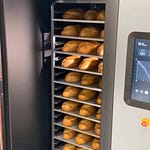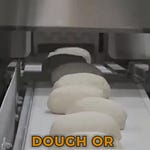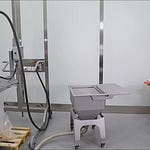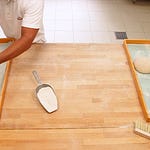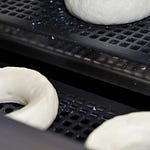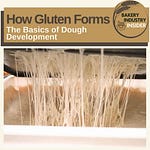In industrial pizza production, the main goal is to shape dough so that it is consistent in both size and quality.
Two techniques dominate in the industry: the Pressure Method and the Sheeting Method. Both achieve the same goal, but through different mechanical and rheological effects on the dough, resulting in distinct crust textures and production outcomes.
Dough Ball Pressing Method
In the pressure method, the dough follows several key steps:
First, dough is divided into precise portions, rounded into balls, and allowed to rest so the gluten relaxes.
Next, each ball is flattened by a press, either cold or hot.
A press can operate at ambient temperature or be heated. A hot press, often heated to around 120–135 °C, lightly warms the surface, creating a thin skin that stabilizes the shape and prevents sticking. This keeps the crust uniform in thickness and diameter.
Proofing can take place at different stages:
Before pressing: dough balls are rested or given a short proof so gluten relaxes and gases develop.
After pressing: a secondary proof may be used if extra volume or a softer crumb is desired.
For example, pan pizzas are often pressed into the pan and then proofed briefly before topping and baking.
Rheological Effects
Pressing happens in one step, so fermentation gases are only partially redistributed. Larger bubbles are broken down, but enough gas is retained for the crust to rise and create a light, open crumb.
The gluten stretches mainly in a radial direction rather than being overworked, which helps preserve dough softness.
To prevent shrinkage after pressing, flours with 11–12% protein are often used. Dough relaxers or higher hydration levels may also be incorporated.
Advantages
Produces crusts with a bread-like, airy texture.
Highly consistent in size and shape.
No dough scrap is generated, making the process efficient.
Compact equipment setup compared to large sheeting lines.
Disadvantages
Requires careful dough conditioning to avoid shrinkage.
Hot presses increase energy costs and must be carefully managed to avoid partial baking of the surface, while cold presses may cause sticking.
Throughput per press is lower, so scaling requires multiple machines.
Each press handles one or a few crusts at a time, which can limit efficiency compared to continuous sheeting lines.
Applications
Common for rising-crust frozen pizzas, pan pizzas, and deep-dish styles. Many commissaries and chain suppliers use presses to replicate the texture of hand-tossed dough at scale.
Molded Sheeter Method
It involves several key steps:
The dough is passed through a series of rollers, gradually reducing thickness.
It may be laminated (folded and re-sheeted) to add layers, especially for cracker-style crusts.
Bases are then cut or stamped from the sheet, often docked with small perforations to prevent bubbling.
While this ensures precision, it also generates scrap that must be recycled into fresh dough.
Rheological Effects
Sheeting exerts more mechanical stress. Rolling expels most fermentation gases and aligns gluten strands, making the dough denser and stronger.
Unless proofing is added, the crust tends to bake into a flat, crisp base.
Excessive sheeting may overwork gluten, causing shrinkage, so relaxers or intermediate resting stages are often required.
Advantages
Guarantees exact weight and thickness for every piece.
Enables fragile and crispy crusts.
Higher throughput
Flexible in size and shape, from round to rectangular or custom designs.
Disadvantages
Scrap handling complicates operations and can affect dough quality, since recycled scrap may be drier, over‑developed, or introduce inconsistencies into new dough batches.
Requires careful gluten management and often additional proofing.
Overworked dough can lead to toughness and shrinkage if process controls are not maintained.
Produces flat crusts unless extra steps are taken to create an edge.
Applications
Preferred for thin-crust frozen pizzas, cracker-style tavern pizzas, and flatbreads. Also widely used in large-scale tortilla and specialty bread production.
👉 Thanks for Reading! 💬 Any experiences to share with us?? – We’d love to hear your story!
Source:




